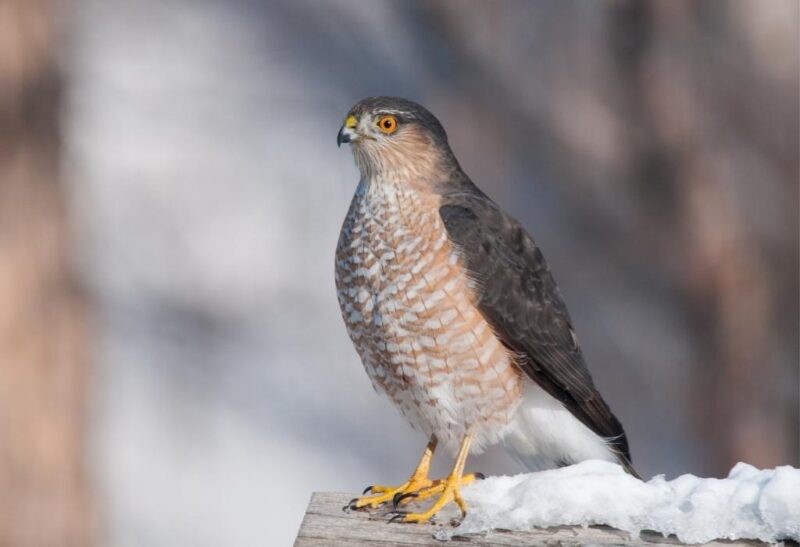There are around 270 hawk species that have different sizes, colors, shapes, behaviors, and habitats.
They’re powerful birds with their sharp, curved talons and hooked beaks, which make them ferocious predators. They occupy savannas, prairies, forests, marshes, grasslands, mountains, and coastal regions.
What are the different hawks found in New Jersey? The different hawks found in New Jersey are the Broad-winged hawk, Red-shouldered hawk, Sharp-shinned hawk, Cooper’s hawk, Northern Harrier, Rough-legged hawk, Northern Goshawk, and Red-tailed hawk.
Despite the large number of migratory birds in New Jersey, you’ll be able to recognize each of these hawks.
It’s possible as they will be described in this article. They’re eight; distinct species that you can easily remember after you read everything about them.
Table of Contents
Are There Hawks in New Jersey?
There are hawks in New Jersey. The earliest detailed records of hawk flights cited in New Jersey are from 1931, 1932, and 1935.
The data were collected by the Audubon Association. Sharp-shinned hawks have the highest number, including their young based on their records.
Hawks continue to occupy New Jersey up to these days for their fall migration in the eastern ridges, where they take advantage of thermal and air currents. When winter comes, they stay in the southern ridges.
8 Hawks in New Jersey
Broad-Winged Hawk
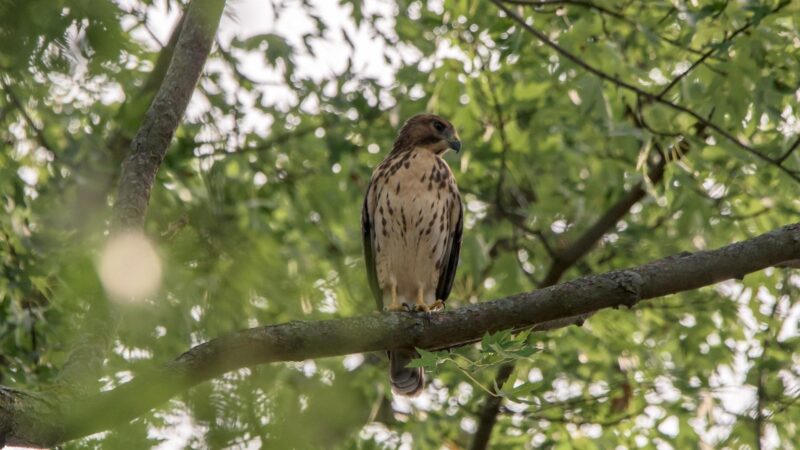
This hawk species chooses to live in the mixed forest where there are water sources and openings. They don’t want to live near humans. Instead, they opt to stay in areas that are elevated for thousands of meters.
- Appearance: A broad-winged hawk is small and stout with pointed wing tips when flying. When it’s full-grown, it has a dark brown back while its underside is pale with chestnut or cinnamon barring. The wing tips don’t touch the tail when this bird is perched on a tree.
- Color: Reddish-brown, black, and white
- Wingspan: 81 to 100 cm
- Lifespan: 12 to 18 years
- Size: 34 to 44 cm
- Weight: 265 to 560 grams
- Diet: Amphibians, birds, insects, mammals, reptiles
- Place of Origin: Nearctic and Neotropical regions
- Characteristics: Solitary; territorial; excellent at soaring; active during the day; migratory; motile
Red-Shouldered Hawk
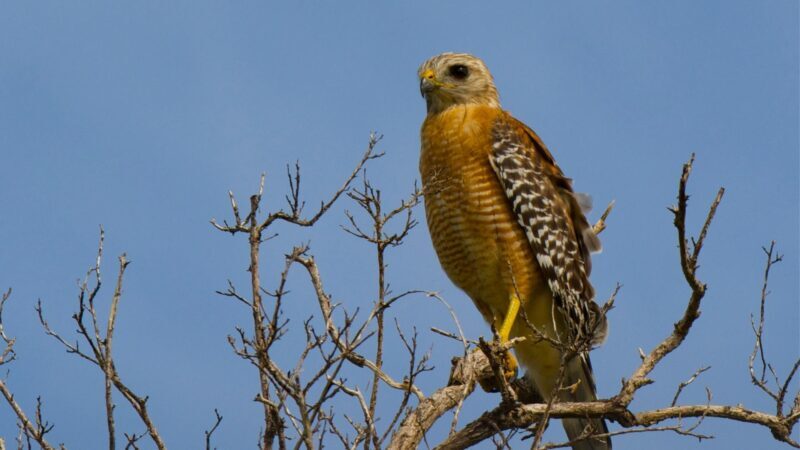
You’ll likely find red-shouldered hawks occupying wet, woodland areas. This species likes to perch on dead trees while enjoying the view below. It doesn’t form flocks even when it’s winter.
- Appearance: It’s a large hawk with broad wings at the same time. Its head is brown while its back is darker. The tail is dark brown too, but it has some white bands.
- Color: Brown, dark brown, red
- Wingspan: 92 to 107 cm
- Lifespan: 19 to 20 years
- Size: 43 to 61 cm
- Weight: 550 to 700 grams
- Diet: Amphibians, aquatic crustaceans, birds, insects, mammals
- Place of Origin: Nearctic region
- Characteristics: Solitary; territorial; most red-shouldered hawks don’t migrate or sedentary; diurnal; motile
Sharp-Shinned Hawk
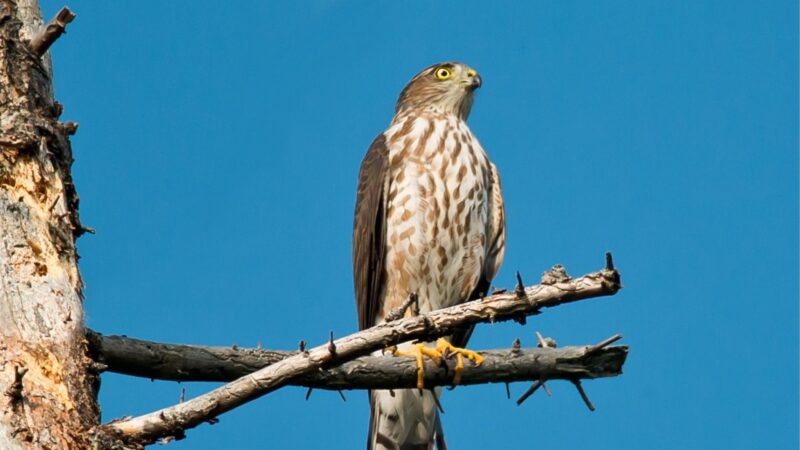
This is the smallest hawk species in North America. But this can be everywhere as it can occupy a wide range of habitats like forests, agricultural areas, and edges of alpine areas. This hawk can be present both in rural and suburban areas.
- Appearance: The upper part of the body of the sharp-shinned hawk is bluish-gray, while its crown is darker. Its wings are dark-colored too, and the undersides are white.
- Color: Bluish-gray, brown
- Wingspan: 53 to 65 cm
- Lifespan: Up to 20 years
- Size: 24 to 34 cm
- Weight: 87 to 218 grams
- Diet: Birds, insects, mammals
- Place of Origin: North America
- Characteristics: Territorial; solitary; diurnal; migratory; motile
Cooper’s Hawk
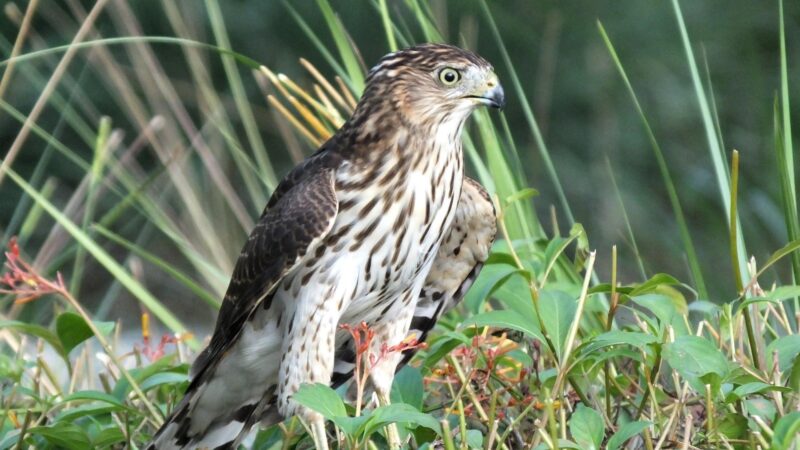
- Appearance: This is a medium-sized hawk with a long, lean body. It has a notable blacking crown due to the light-colored nape. In terms of hunting, it has an excellent ability due to its great depth perception.
- The flying ability of Cooper’s hawk is outstanding, as well since it can fly even at a high speed.
This hawk has a hooked bill that’s used to easily tear the flesh of its prey. It has a rapid wingbeat, so it can go through vegetated woodlands.
- Color: Black, blue-gray
- Wingspan: 75 to 94 cm
- Lifespan: 12 to 20 years
- Size: 35 to 50 cm
- Weight: 280 to 566 grams
- Diet: Amphibians, birds, mammals, and reptiles
- Place of Origin: Nearctic and Neotropical regions
- Characteristics: Arboreal; diurnal; migratory; motile; territorial; solitary; ambush passing birds
Northern Harrier

Aside from North America, this hawk is also found in Europe and the northern part of Asia and Africa. It prefers inhabiting open areas like meadows, fields, savannas, desert steppe, and upland prairies.
- Appearance: Several characteristics can make it easy to spot a northern harrier. Not all hawks have specialized feathers that surround a bird’s face. It forms into a disk to direct sound and noises in its ears.
- This hawk glides with dihedral wings. You’ll also see a distinct white rump patch when this hawk is in flight. It has yellow eyes too.
- Color: White, brown, gray
- Wingspan: 380 to 384 cm
- Lifespan: Up to 16 years
- Size: 41 to 50 cm
- Weight: 290 to 600 grams
- Diet: Amphibians, birds, mammals, and reptiles
- Place of Origin: Throughout the Northern hemisphere
- Characteristics: Migratory; glides; diurnal; motile
Rough-Legged Hawk
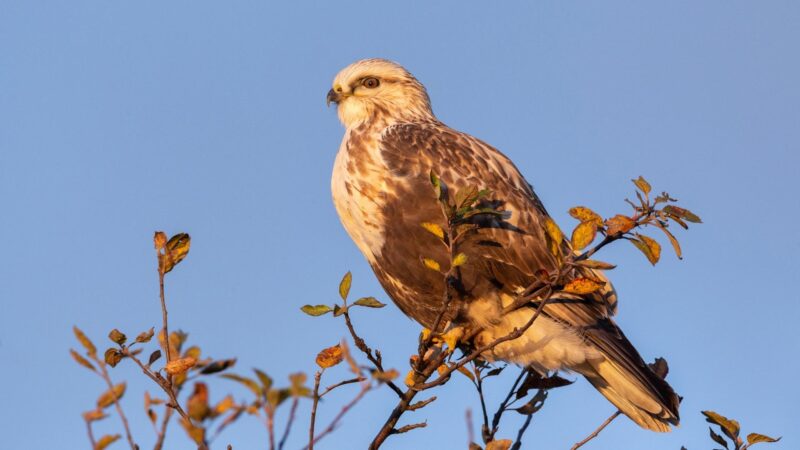
A rough-legged hawk usually migrates alone. It’s rare to see this species fly in a group. The males can do the ‘sky dance’ in which they can be seen soaring high, diving, and doing other tricks before returning to the normal flight. It prefers to dwell in an open area, and it loves hunting prey in shrublands and grasslands.
- Appearance: When this hawk is fully mature, it becomes a rough-legged bird. There’s a black band on its underside, and its eyes are dark too. The majority of rough-legged hawks are dark, but some have pale brown heads.
- Color: Brown, gray
- Wingspan: 122 to 134 cm
- Lifespan: 18 to 24 years
- Size: 46 to 59 cm
- Weight: 745 to 1,380 grams
- Diet: Birds, reptiles, and mammals
- Place of Origin: Holarctic
- Characteristics: Glides; territorial; solitary; motile; diurnal; migratory
Northern Goshawk
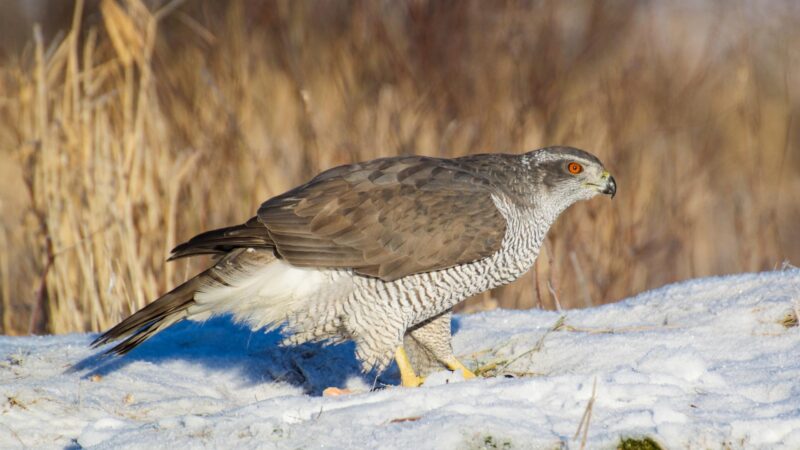
This is the largest in the accipiter family. Its preferred habitat is deciduous and coniferous forests. In winter, it migrates to warmer areas that are at lower elevations.
- Appearance: White feathers are formed as a band above its eyes. The color ranges from black to blue-gray, but it has white and brown vertical streaks on its underside.
- Color: Bright yellow, reddish-brown, blue-gray, black
- Wingspan: 98 to 115 cm
- Lifespan: 11 to 19 years
- Size: 55 to 61 cm
- Weight: 631 to 1,364 grams
- Diet: Birds, insects, mammals, and reptiles
- Place of Origin: Palearctic and Nearctic regions
- Characteristics: Sedentary; solitary; diurnal; motile; migratory
Red-Tailed Hawk
Red-tailed hawks live in various places with different altitudes too. It means that you’ll likely see them everywhere.
But they usually build their nests in trees in an open area, in wooded fence rows, and on the edge of the forest.
- Appearance: The color of this species ranges from deep brown to light auburn. It got its name from its brownish-red tail.
- Color: Deep brown, brownish red, light auburn, red
- Wingspan: 122 cm (average)
- Lifespan: 28 to 29 years
- Size: 45 to 65 cm
- Weight: 795 to 1,224 grams
- Diet: Birds, reptiles, and mammals
- Place of Origin: Nearctic region
- Characteristics: Diurnal; territorial; migratory; motile; diurnal
Frequently Asked Questions
What Is the Biggest Hawk in New Jersey?
The biggest hawk in New Jersey is a Rough-legged hawk, scientifically called ‘Buteo lagopus’. Its average weight is around 1,026 grams, while the average wingspan is 134 cm.
Can You Shoot Hawks in New Jersey?
You can’t shoot hawks in New Jersey because of some statutes. The first prohibition is from the Migratory Bird Treaty Act. It was implemented in 1918 to protect migratory birds like hawks.
New Jersey also included the Red-shouldered hawk in the list of the State of New Jersey’s Endangered and Threatened Wildlife.
Cooper’s hawks and Sharp-shinned hawks are protected by New Jersey state law. A man in New Jersey was found guilty of violating the federal act. He’s required to serve six months in prison and pay a penalty.
What Is the Rarest Bird in New Jersey?
The rarest bird in NJ is the Golden-winged warbler. It was discovered in Sparta Mountain, New Jersey by Sharon Petzinger, a senior zoologist in the NJ Division of Fish and Wildlife.
Moreover, it was photographed by John Parke, a New Jersey Audubon Stewardship Project Director.
The golden-winged warbler is a migrant that goes to North America for breeding that happens in spring. Hence, it was found in New Jersey in the 2020 breeding season. This bird prefers to dwell in a young forest.
Its presence in Sparta Mountain proves that the effort of the New Jersey Working Lands for Wildlife staff is fruitful.
They spent eight years working on a cultivated site where the golden-winged warbler was spotted.
Are Hawk and Falcon the Same?
Although they’re both raptors, hawks and falcons are not the same. Falcons are smaller than hawks, but they have longer wings. In terms of flying, hawks are slower than the falcons.
The curve beak is seen on hawks, while the falcon’s beak has a notch that is equivalent to a tooth.
Summary
It’s fun to know different hawk species, and each of them has a distinct feature. Some have even unique abilities that can amaze you while looking at them.
These migrant birds are a sight for sore eyes in New Jersey. But they’re protected by the state and Federal governments. So, bird watching can be fun but shooting the birds has consequences.
List of Sources
Kirschbaum, K., Ivory, A. (1999). Buteo platypterus. Animal Diversity Web.
Kirschbaum, K., Miller, S. (2000). Buteo lineatus. Animal Diversity Web.
Limas, B. (2001). Circus cyaneus. Animal Diversity Web.
South Jersey Man Admits Shooting Four Species Of Protected Hawks In His Residential Neighborhood. (2015). United States Department of Justice.
Allen, R. P., Peterson, R. T. (1936). The Hawk Migrations at Cape May Point, New Jersey. Searchable Ornithological Research Archive.
